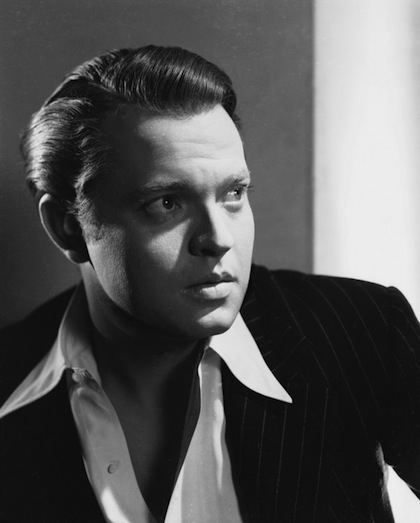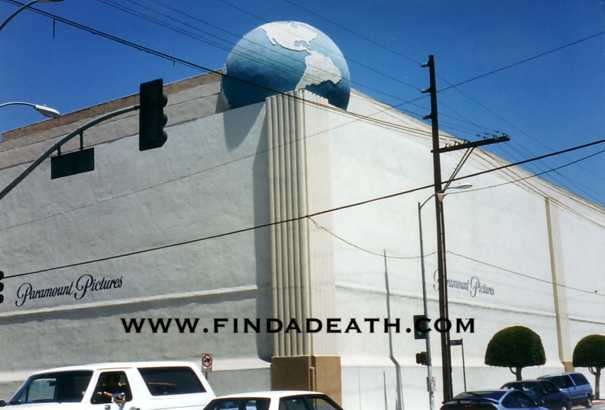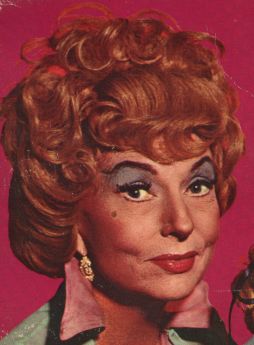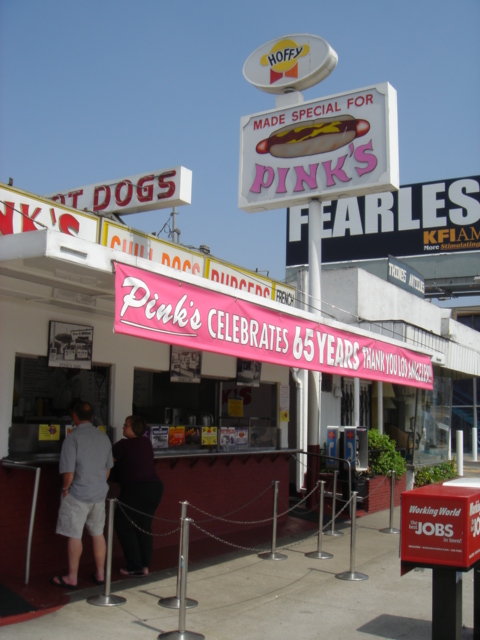May 6, 1915 – October 10, 1985

by Chris Dandeneau
Bit of background: George Orson Welles was born May 6, 1915 in Kenosha, Wisconsin, to Beatrice Ives Welles (suffragist, community activist, and accomplished pianist) and Richard Head Welles (inventor and businessman). His birthplace at 6116 Seventh Avenue (in 1915 it was 463 Park Avenue), is now part of Kenosha’s Library Park Historic District. Welles was the second of his parents’ two children, the oldest being Richard Ives Welles Jr. (b. 1905). Richard Jr. was a huge disappointment to his father, and was later committed to the Kankakee Institute in Wisconsin. In her biography on Orson Welles, Barbara Leaming wrote about an instance when a corpse reported to be Richard Jr. (it wasn’t) washed up on the banks of the Mississippi River. According to Leaming, Orson remembered his father saying, “That’s good, at least the family is rid of him!” Orson’s father was an alcoholic and a womanizer, so his marriage seemed doomed from the start. Orson’s parents separated when he was 6. In 1924, Orson’s mother – thought by many to be the artistic influence in his life – died of jaundice. Six years later, Orson’s father died of heart and kidney failure. Orson received most of his father’s estate, with only a small portion going to Richard Jr. In 1937, Welles co-founded the Mercury Theatre, which performed at the Comedy at 108 West 41st St. in New York (the Comedy was demolished in 1970). Welles expanded the Mercury operation in July of 1938, to include weekly radio dramas for CBS. Known as Mercury Theatre on the Air, it garnered infamy with its October 30, 1938 broadcast of The War of the Worlds. (Not to be confused with the psychotic meltdown we’ve been privy to recently) This clever adaptation of the H.G. Wells’ classic caused panic for thousands of listeners, who thought an actual invasion from Mars was taking place. The chaos created by the broadcast helped Welles gain international fame. In 1939, Welles signed with RKO Radio Pictures, Inc., at the time one of Hollywood’s “Big Five” film studios.


After a few failed attempts to make a film (one of which was based on Joseph Conrad’s Heart of Darkness – later the basis for Apocalypse Now), Welles struck gold with Citizen Kane. While the film was not commercially successful at the time of its release, it is now considered by many critics to be the best motion picture ever made. At its most simplistic, Citizen Kane tells the story of the rise and subsequent fall of a rags-to-riches child. The film was controversial even before its release, because it appeared to be a fictional account of the powerful real-life newspaper publisher, William Randolph Hearst. Spurred on by Hollywood gossip witches, Hedda Hopper and Louella Parsons, Hearst tried to keep the film from ever seeing the light of day. One story by Welles claims that he was tipped off by police that Hearst had planted an underage girl and two photographers in his hotel room, in an attempt to have leverage for blackmail. A terrific film based on this story is called RKO 281.
Regardless, the commercial failure of Citizen Kane was seen by many as a direct result of boycotts and threats made by Hearst. The irony of the Hearst-Kane fiasco is that while Hearst tried vehemently to keep the population from seeing the film, many people only recognize the name William Randolph Hearst in association with Citizen Kane. The film was successful with critics at its time of release, receiving nine Oscar nominations (it was booed during the ceremony) and winning one, for Best Original Screenplay. That particular Oscar statuette was auctioned off in 1999.
Welles’ follow-up to Kane, The Magnificent Ambersons (1942), would foreshadow some of the problems that Welles would face in his career as a filmmaker. During production of Ambersons, Welles was asked by the U.S. government to shoot a documentary about South America. While working on that project (titled It’s All True) in Brazil, RKO took control of Ambersons and proceeded to do some heavy editing. It’s All True became one of Welles’ many endeavors throughout his career that would remain unfinished. Welles developed a reputation in Hollywood as a fiscally irresponsible director, who had trouble keeping to schedule. Throughout his life’s work, he would be plagued with problems of film financing and studio interference.
In the late 1940s, Welles moved to Europe. It was here the filmmaker, effectively exiled from Hollywood, would produce much of his later work. The creative and filmmaking independence Welles insisted upon, ultimately led to reduced budgets. Some of the films made by him in Europe include Othello (1952 Palm d’Or winner) and The Trial (1963). In 1971, Welles received an honorary Academy Award. He was now being praised by the same Hollywood that had previously shunned him.
Welles was frequently overweight, but became obese later in life. For the last decade or so of his life, he was reduced to doing commercials and made regular appearances on the talk-show circuit, often drunk.


Welles’ final roles were as the voice of Unicron in Tranformers: The Movie (released in 1986), and an introduction to a black and white sequence for an episode of Moonlighting. For all other credits, visit here.
The night before the Cybil Shepherd/Bruce Willis show, Welles appeared drawn and haggard during a luncheon with Burt Reynolds at Ma Maison. That happens a lot to Burt Reynolds.
George Orson Welles died of a heart attack in this home on October 10, 1985.


Probably in the Master Bedroom.


Orson died on the same day as Yul Brynner and the same week as Rock Hudson and Nelson Riddle. One report states that it wasn’t Welles’ home, but the home of friend Aleksander Deviec in which he drew his last breath.


He was cremated, and his ashes were buried inside an old well on the property of retired bullfighter, Antonio Ordonez (who died on December 19, 1998), in Ronda, Malaga, Spain.
Fact I’ve saved in my Orson file for years, from Bob in TN: Welles and his wife shared a little poodle, Kiki. On occasion, the poodle would be transported from LA to Vegas, via limousine, with instructions from Orson to stop at Barstow and exercise the dog for 15 minutes.
Marriages and children: Orson Welles was married three times, most notably to Rita Hayworth (which makes me believe love exists). His first marriage was to Virginia Nicholson, an actress whom he directed in his short film The Hearts of Age (shot at the age of 19). The couple had one daughter, Christopher Welles, born March 27, 1938. They divorced in February of 1940. Rita Hayworth, who needs no description, was Welles’ second wife. The two met during a production of a story called There Are Frenchmen and Frenchmen for The Orson Welles Show. The couple had one daughter, Rebecca Welles, on December 17, 1944. Hayworth and Welles were divorced in 1948. Orson’s third (and last) wife was an Italian actress named Paola Mori, whom he met at a cast party for the film The Adventures of Don Juan (1948). The couple had one daughter, Beatrice Welles, on November 13, 1955. In 1962, while married to Mori, Welles met Oja Kodar during the filming of his movie The Trial. For the rest of his life, Welles would remain married to Mori but keep a relationship going with Kodar. Upon Welles’ death, there was a dispute over the terms of his will. Mori and Kodar were to settle the dispute through a signed agreement on August 14, 1986, but Mori was killed in a car accident on August 12, 1986, (missed it by that much!).
Some random notes: In the film Citizen Kane, there is a scene where Kane’s close friend, Jedidiah Leland (Joseph Cotton), is drunk after Kane (Orson Welles) loses his election bid for governor of New York. Leland informs Kane that he wants a transfer to their Chicago paper. Leland makes his case by saying to Kane, “Well, you said yourself, you were looking for someone to do dramatic crimitism” The use of “dramatic crimitism” (instead of “dramatic criticism”) was unintentional. Welles – probably thinking that the scene was going to be reshot – shows a faint smirk. The scene was not re-shot, and the flubbed line actually adds some realism to Leland’s drunken state.
Citizen Kane was also the motion picture debut of Agnes Moorehead. She played Kane’s mother.


Orson Welles, and past presidents John Adams and John Quincy Adams, were all descendants of John Alden, a passenger on the Mayflower.
Orson Welles turned down the chance to be the voice of Darth Vader.
He was also considered for the part of Mr. Roarke, on Fantasy Island.
Sweet Lady Jane at 8360 Melrose Ave. in LA is said to be haunted by a ghost of Orson Welles.


The website for Sweet Lady Jane has the bakery opening on May 5, 1988. Q: Welles died in 1985 so was there a different business there, or am I missing something? A: I phoned Sweet Lady Jane, and apparently it is in the location of the old Ma Maison restaurant, frequented by Orson Welles (and where murderer John Sweeney worked). Nice Bonnie explained that someone once offhandedly mentioned that Orson ate there, so often he probably haunts the place now. It got repeated, and now is legend.


Pinks was another favorite spot of Orson Welles. He is said to have eaten 17 hot dogs in one sitting. In June of 2012 Los Angeles Magazine’s Ask Chris went to Pinks for the answer:


A Sedona home (65 Sycamore Road) that Welles rented with Paola Mori and his daughter, Beatrice, was on sale (found it on the internet) for almost $1.4 million.
Citizen Kane costar and former David Gest beard, Ruth Warrick, died in January 2005.




Some Orson Welles quotes:
“The best thing commercially, which is the worst artistically, by and large, is the most successful.”
“If you want a happy ending, that depends, of course, on where you stop your story.”
“Man is a rational animal who always loses his temper when called upon to act in accordance with the dictates of reason.”
“My doctor told me to stop having intimate dinners for four – unless there are three other people.”
References:
The Encyclopedia of Orson Welles – Chuck Berg and Tom Erskine
Orson Welles – Barbara Leaming
Rosebud: The Story of Orson Welles – David Thomson
Check out this great link about the “Martian landing site” from War of the Worlds, HERE.
thanks Harry.

I just read an interesting article about Welles: his last interview was on the Merv Griffith show.
He died later on that night…
http://www.tvparty.com/70-orson-welles.html?fbclid=IwAR31R99uwALOquCPSz0kKadaTpuU1PpzgXAU6iiUEI6aYEcO5eMaC_b2wkA
I should have mentioned this on Maila’s page as well( I will wait for my last comment to get through the mod) but in the book “Glamour Ghoul: The Passions and Pain of the Real Maila Nurmi” Mister Welles is reportedly the father to one more child; a living son with whom he shared biological parentage with Maila. While Maila has been proven the mother of the child in question, his paternity has not yet been established with the use of Orson’s familial DNA. I certainly hope that, somehow, it will be. As a fascinating(tragic) ear worm, Maila’s grown son became an accomplished lawyer who was schoolmates(and still friends) with President Joe Biden. He has done work overseas and lives happily with his partner now; I cannot help but think that Maila could have used his help in her legal battles(and just in general) as she aged and declined in health.
If I find out anything else, I will keep you ghosted.. you should really read the book. 🦇